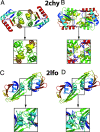Emergence of symmetry in homooligomeric biological assemblies
- PMID: 18849473
- PMCID: PMC2570982
- DOI: 10.1073/pnas.0807576105
Emergence of symmetry in homooligomeric biological assemblies
Abstract
Naturally occurring homooligomeric protein complexes exhibit striking internal symmetry. The evolutionary origins of this symmetry have been the subject of considerable speculation; proposals for the advantages associated with symmetry include greater folding efficiency, reduced aggregation, amenability to allosteric regulation, and greater adaptability. An alternative possibility stems from the idea that to contribute to fitness, and hence be subject to evolutionary optimization, a complex must be significantly populated, which implies that the interaction energy between monomers in the ancestors of modern-day complexes must have been sufficient to at least partially overcome the entropic cost of association. Here, we investigate the effects of this bias toward very-low-energy complexes on the distribution of symmetry in primordial homooligomers modeled as randomly interacting pairs of monomers. We demonstrate quantitatively that a bias toward very-low-energy complexes can result in the emergence of symmetry from random ensembles in which the overall frequency of symmetric complexes is vanishingly small. This result is corroborated by using explicit protein-protein docking calculations to generate ensembles of randomly docked complexes: the fraction of these that are symmetric increases from 0.02% in the overall population to >50% in very low energy subpopulations.
Conflict of interest statement
The authors declare no conflict of interest.
Figures


References
-
- Crick FH, Watson JD. Structure of small viruses. Nature. 1956;177(4506):473–475. - PubMed
-
- Goodsell DS, Olson AJ. Structural symmetry and protein function. Annu Rev Biophys Biomol Struct. 2000;29:105–153. - PubMed
-
- Monod J, Wyman J, Changeux JP. On the nature of allosteric transitions: A plausible model. J Mol Biol. 1965;12:88–118. - PubMed
Publication types
MeSH terms
Substances
Grants and funding
LinkOut - more resources
Full Text Sources
Other Literature Sources

